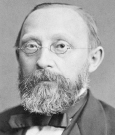At the third annual Preventing Overdiagnosis Conference, speakers described the prevalence and consequences of overdiagnosis in several medical specialties, including cancer. The Conference, which had the theme “Winding Back the Harms of Too Much Medicine,” was co-sponsored by the National Cancer Institute Division of Cancer Prevention and the University of Oxford Centre for Evidence-Based Medicine and drew about 350 international participants to the National Institutes of Health in Bethesda, Maryland.
Defining Overdiagnosis
Cancer overdiagnosis is defined as “the detection of asymptomatic cancers, often through screening efforts, which are either nongrowing or so slow growing that they never would have caused medical problems for the patient in the patient’s lifespan,” according to Barry Kramer, MD, MPH, Co-Chair of the Conference Planning Committee and Director of the Division of Cancer Prevention, National Cancer Institute. “They therefore represent an important cause of overtreatment, which can involve serious harms and toxicities such as deaths from surgery, major organ deformation or loss, and second cancers from radiation or chemotherapy.”
Keynote speaker Otis W. Brawley, MD, MAACP, Chief Medical and Scientific Officer, American Cancer Society, said cancer overdiagnosis stems from the 19th century definition of cancer pathologist Rudolph Ludwig Carl Virchow as always being a disease of uncontrolled cell growth. This led to the concept that “all cancers are bad,” Dr. Brawley said. “The histologic definition of cancer used in 2015 is largely that of Virchow and colleagues, with very minor modifications.”
Yet, with today’s technology, cancer can be diagnosed earlier in development than in Virchow’s day, Dr. Brawley said. “It is actually possible now through our new technologies to find a 5- or 6-mm lesion in a woman’s breast, stick a needle into it, biopsy it, send it to a pathologist who uses the same technologies developed in the 1850s and 1860s—a light microscope, which has evolved in that it now has an electric light bulb as a light source—and says, ‘This looks just like what Virchow said killed the woman who had the autopsy in 1853.’ It looks just like something that killed 162 years ago, and our assumption is that it’s going to kill now,” he said.
“Those of you in the United States are familiar with racial profiling. This is pathologic profiling,” Dr. Brawley said. Some of these small, localized tumors are not genomically or genetically programmed to grow or spread, he added.
“We are moving from a mid-19th century definition of cancer to a 21st century definition of cancer that includes not just histology, but also genomics and epigenomics, and we’re beginning to appreciate the biologic behaviors of tumors,” such that several distinct types of breast cancer and other cancers can be identified and treated differently, Dr. Brawley explained.
Cancer overdiagnosis is estimated to occur in 10% to 20% of radiologically detected lung cancers, up to 50% of mammographically detected breast cancers, and 40% to 60% of prostate cancers, Dr. Brawley said. Better terminology and biomarker research could help reduce the rate of overdiagnosis, he added.
Regarding whether ductal carcinoma in situ should be called a “cancer,” Dr. Brawley quoted the late University of Chicago Pathology Professor Seymour Glagov, MD, who held that true cancer is invasive and “in situ” means not invasive. “He insisted that ductal carcinoma in situ was not cancer,” Dr. Brawley said.
“We need to get back to basic principles,” Dr. Brawley urged. “It’s likely that some things that are ductal carcinoma in situ under the microscope are cancers, but most things that are ductal carcinoma in situ under the microscope are not cancers, and it is clear we have been overtreating ductal carcinoma in situ and doing a disservice to women by considering all ductal carcinoma in situ as cancer.”
Personalized Breast Cancer Screening
Understanding the basis for overdiagnosis can drive solutions to mitigate harm, said Laura Esserman, MD, MBA, Professor of Surgery and Radiology and Director of the Carol Franc Buck Breast Care Center at University of California, San Francisco. One driving factor in overdiagnosis is overscreening, she said.
Dr. Esserman and her team recently won a 5-year, $14.1-million award from the Patient-Centered Outcomes Research Institute to investigate whether a risk-based personalized approach to breast cancer screening is as safe and effective as annual mammograms. The WISDOM study will involve approximately 100,000 women between the ages of 40 and 80 years old from all five University of California medical centers and Stanford. Women at higher risk of breast cancer will be screened more often than those at lower risk (wisdomstudy.org).
“Risk-based screening has the potential to improve the way we think about tailoring prevention and treatment, because we are going to profile every tumor that is diagnosed on women on the trial” to identify groups that have lower-risk tumors, Dr. Esserman said. “Maybe that’s the group of women where we can just stop screening or screen much less and eventually stop screening. Why should we be looking for little bitty calcifications? Let’s stop looking for things that don’t matter.”
Women will be randomized either to the personalized or the annual screening arm. Participants in the personalized screening arm will receive a risk assessment evaluating family and medical histories, breast density, and tests for genes linked to the development of breast cancer. Those with the highest risk of developing breast cancer will receive recommendations to begin screening at an earlier age, have mammograms more often, and continue screening until they are older. Those with the lowest risk will begin screening later, have less frequent screening, and stop screening earlier. No woman will be screened less often than the U.S. Preventive Services Task Force recommendations.
The two strategies will be compared to determine whether personalized screening is as safe as annual screening and whether it will reduce false-positive results and overdiagnosis.
Mammographic screening currently costs the U.S. health-care system about $7.5 billion a year. If the U.S. Preventive Services Task Force guidelines were fully implemented, costs would fall to about $3 billion, Dr. Esserman said. ■
Disclosure: Drs. Kramer, Brawley, Glagov, and Esserman reported no potential conflicts of interest.





